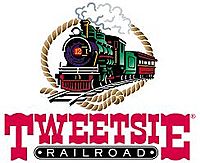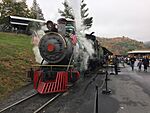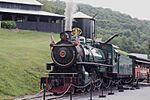Tweetsie Railroad facts for kids
 |
|
| Location | Blowing Rock, North Carolina, U.S. |
|---|---|
| Coordinates | 36°10′15″N 81°38′57″W / 36.170930°N 81.649029°W |
| Opened | July 4, 1957 |
| Owner | Tweetsie Railroad, Inc. |
| Theme | Wild West |
| Operating season | April - December |
| Area | 200 acres (81 ha), 30 acres (12 ha) developed |
| Attractions | |
| Total | 16 |
Tweetsie Railroad is a super fun theme park in the Blue Ridge Mountains of North Carolina, USA. It's located between the towns of Boone and Blowing Rock, North Carolina. This park is all about the Wild West and is perfect for families with kids.
The main attraction is an exciting three-mile train ride. You get to ride on a real steam locomotive! Tweetsie Railroad has two historic narrow-gauge steam engines that pull the trains.
Besides the train ride, the park has lots of other cool things to do. There are many amusement rides, exciting live shows, and even a small zoo. Tweetsie Railroad also hosts special events throughout the year, like fun Halloween and Christmas celebrations.
Contents
The Story of Tweetsie Railroad
The history of Tweetsie Railroad goes way back to the late 1800s. That's when special narrow-gauge railroads started reaching into the faraway parts of the Blue Ridge Mountains.
One of the most important parts of Tweetsie Railroad is its historic Locomotive No. 12. This steam engine was built in 1917. It's a special kind of train that ran on tracks that were three feet wide. From 1918 to 1940, Locomotive No. 12 carried people and goods for 66 miles between Johnson City, Tennessee, and Boone, North Carolina.
Where the Name "Tweetsie" Came From
Local people gave the original railroad the nickname "Tweetsie." It sounded like the letters "ET&WNC" when said quickly. But it also sounded like the "tweet" of the train whistles echoing through the mountains! The name stuck, and soon everyone knew the railroad as Tweetsie.
In 1950, the narrow-gauge part of the ET&WNC railroad stopped running. Two years later, a group of train fans bought Locomotive No. 12. They moved it to Virginia to start a new railroad called the Shenandoah Central Railroad. This new railroad opened in May 1953.
But then, a big storm called Hurricane Hazel hit in October 1954. It washed out the tracks of the Shenandoah Central. So, Locomotive No. 12 was for sale again. A famous cowboy actor and singer named Gene Autry thought about buying it. He wanted to use it in movies in California. But he realized it would cost too much to move and fix the train, so he didn't buy it.
Becoming a Fun Park
Grover Robbins, a smart businessman from Blowing Rock, North Carolina, heard that the train was available. He bought Gene Autry's chance to buy the train for just one dollar! Then, in August 1955, Robbins paid $17,000 to buy Locomotive No. 12.
Grover Robbins wanted to bring the train back to its mountain home. He found a good spot between Boone and Blowing Rock. Workers built one mile of track. After the train was fixed up, it was brought back to the Blue Ridge Mountains.
The train quickly became the main attraction for a new tourist spot called "Tweetsie Railroad." On July 4, 1957, the locomotive made its first public trip on the new track. In 1958, the track was made longer, creating a three-mile loop around the mountain. Tweetsie trains have been traveling that loop ever since! Grover Robbins' brothers, Harry and Spencer, also helped run the park. The Robbins family still owns and operates Tweetsie Railroad today.
In 1960, Tweetsie got another steam locomotive, No. 190, also known as the "Yukon Queen." This engine was built in 1943 for the US Army during World War II. It was used in Alaska before coming to Tweetsie.
Tweetsie Railroad became very popular. It quickly grew into the first theme park in North Carolina, and one of the first in the whole country! A western town and a saloon were built around the train station. Fun shows like train robberies and cowboy-and-Indian acts were added to the train ride. This Wild West theme was very popular in movies and on TV at the time.
In 1961, a chairlift and an amusement ride area were built on the mountain inside the train loop. Over the years, the park has added even more rides, attractions, shops, a zoo, and places to eat.
Tweetsie's Connection to Dollywood
In 1961, Grover and Harry Robbins also built another theme park in Tennessee. It was first called "Rebel Railroad." Later, it became "Goldrush Junction," with a Wild West theme, much like Tweetsie Railroad. The Robbins brothers sold Goldrush Junction in the late 1960s.
Years later, in 1986, famous country music star Dolly Parton became a part-owner of the park. That's when it became the famous Dollywood theme park we know today! The train there still runs and is called the Dollywood Express.
Visiting Tweetsie Railroad
Tweetsie Railroad is located on US 321 between Boone and Blowing Rock, North Carolina. It's easy to find!
The park's Wild West season runs from April to October. In the spring and fall, the park is open on weekends. From late May until mid-August, it's open Thursdays through Mondays (closed Tuesdays and Wednesdays).
Tweetsie also has special nighttime events! From late September through October, you can experience the "Ghost Train" for Halloween. After Thanksgiving, the park re-opens for "Tweetsie Christmas," which runs through December. Other fun events happen all season, like a big fireworks show on the Fourth of July and Railroad Heritage Weekend in August.
Besides the train adventure and rides, Tweetsie Railroad has many live shows. They also host special days for school groups, a "Day Out With Thomas" event with Thomas the Tank Engine, and the spooky "Ghost Train" at Halloween.
Keeping the Trains Running
Tweetsie Railroad has its own special workshop to take care of its two steam locomotives. This workshop is so good that it also helps repair and maintain other narrow-gauge steam locomotives! Trains from other theme parks like Busch Gardens, Dollywood, Six Flags, and Walt Disney World come to Tweetsie for service.
Rides and Attractions
Tweetsie Railroad has many exciting rides for all ages! Here are some of them:
- "Buckaroo Drop" Drop Tower ride
- "Tornado" spinning ride
- "Barrels of Fun" Spinning roller coaster
- Carousel
- Tilt-a-whirl
- Ferris wheel
- "Tweetsie Twister" scrambler ride
- Chairlift
- Turnpike Cruisers (drive your own car!)
- Himalaya
- The Bullwhip pendulum ride
- Little Drummer Boy, a classic teacups ride (only runs during Tweetsie Christmas)
- Mouse Mine Train (a small train ride through a tunnel with animatronic characters)
- Mini Swing
- F-80 Jet Planes
- Kiddie Boats
- Red Baron-type planes and helicopters
- Bikes & Buggies flat ride
Beyond the rides, you can enjoy live shows at the Tweetsie Palace Saloon and Diamond Lil's Can-Can Revue. You can also try gold panning and gem mining, visit the Deer Park zoo, explore unique shops, grab some food, and play games in the arcade.
Locomotives
See also
- Land of Oz (theme park): another park developed by Grover Robbins
- Dollywood: amusement park in Pigeon Forge, Tennessee
- Silver Dollar City: amusement park in Branson, Missouri



